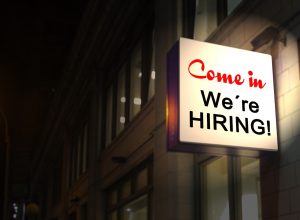Patrick Healy says he did everything right in his job search. After being laid off as a designer early on in the pandemic, Healy, 36, tried his hand at a couple of entrepreneurial ventures before looking for a new full-time position at the start of 2021. He estimates he applied for hundreds of positions, relying on nearly a dozen jobs boards, researching potential employers, and writing personalized cover letters to accompany his résumé.
For the most part, he heard nothing back, regardless of how qualified he was.
“You get no feedback. I was still trying to experiment with what I was doing, but I just had no idea what was happening, why I wasn’t moving forward,” Healy said. “That was both stressful financially and heartbreaking psychologically.”
It took nearly six months for Healy, who has a decade of experience in industrial design, to find a new job. Meanwhile, headlines touted a record number of job openings, and many employers said they were doing everything in their power to entice potential employees.
For Healy and many others, the situation just doesn’t make sense — there’s an incongruity between what they are hearing about jobs and what is actually happening.
For some of the jobs available, people don’t have the right skills, or at least the skills employers say they’re looking for. Other jobs are undesirable — they offer bad pay or an unpredictable schedule, or just don’t feel worth it to unemployed workers, many of whom are rethinking their priorities. In some cases, there are a host of perfectly acceptable candidates and jobs out there, but for a multitude of reasons, they’re just not being matched.
There are also workers who are hesitant to go back — they’re nervous about Covid-19 or they have care responsibilities or something else is holding them back.
The result is a disconnected environment that doesn’t add up, though it feels like it should. The Bureau of Labor Statistics says there are 8.4 million potential workers who are unemployed, but it also says there are a record 10.9 million jobs open. The rate at which unemployed people are getting jobs is lower than it was pre-pandemic, and it’s taking longer to hire people. Meanwhile, job seekers say employers are unresponsive.
There’s no single party to blame here. Corporate hiring practices can be convoluted and too reliant on machines, and many applicants aren’t being realistic or strategic enough in their work search efforts. For employers, job seekers, and the American economy in general, it’s worth figuring out what’s going on and addressing it. Because although these trends have been exacerbated by the pandemic, many of them pre-date it, and they’re not going away.
The difficult, undesirable job market
Essentially anywhere you go in the United States right now, you’re going to encounter “help wanted” signs. But just because a bar or restaurant or gas station wants a worker doesn’t mean a worker wants to work for them. The millions of jobs available aren’t necessarily millions of jobs people want.
“A lot of what people are seeing are low-paying jobs with unpredictable or not-worker-friendly scheduling practices, that don’t come with benefits, don’t come with long-term stability,” Shelly Steward, director of the Future of Work Initiative at the Aspen Institute, told Recode. “And those are not the types of jobs that any worker is eager to take on.”
A survey of workers actively searching for a job on FlexJobs, a jobs website that focuses on remote and flexible work, found that about half of job seekers said they were not finding the right jobs to apply for. Some 46 percent of respondents said they were only finding jobs that are low-paying, while 41 percent said there weren’t enough openings in their preferred profession.
Washington, 68, chalks it up to a combination of age discrimination and not having a college degree, which many positions were requiring even when it didn’t seem necessary. When she did get replies, jobs would offer her much less than what she was paid before, sometimes even less than what was advertised. Or, they would offer to pay her requested hourly rate — but only for part-time work. “It was a grand opportunity to push the secretarial opportunities and incomes back,” she said.
Tim Brackney, president and COO of management consulting firm RGP, refers to the current situation as the “great mismatch.” That mismatch refers to a number of things, including desires, experience, and skills. And part of the reason is that the skills necessary for a given job are changing faster than ever, as companies more frequently adopt new software.
“Twenty years ago, if I had 10 years experience as a warehouse manager, the likelihood that my skills would be pretty relevant and it wouldn’t take me that long to get up to speed was pretty good,” Joseph Fuller, a management professor at Harvard Business School and co-author of a recent paper on the disconnect between employers and employees, said. “The shelf life of people’s skills for a lot of decent-paying jobs has been shortening.”
The pandemic has also made the specter of in-person work less attractive — if not dangerous — so many people are now looking for jobs where they can work from home. The vast majority of workers, regardless of industry, say they want to work from home at least some of the time. While the number of remote jobs has certainly risen, they still only represent 16 percent of job listings on LinkedIn, though they receive two and a half times as many applications as non-remote work.
The problem, however, may not only be on the hiring side. The pandemic has made people rethink their lives and their work, and some individual job seekers may be applying for jobs they want but aren’t suitable for. About half of the FlexJobs respondents searched for jobs outside their current field.
“A lot of reasons that job searches fail is people want to go from unemployment to the next job they would have had if they kept their old job,” Fuller said. “You know, ‘I’m going to not only get a new position, but I’m going to get promoted to boot.’”
Hiring lacks a human touch — sometimes literally
As much as employers say they’re looking hard for employees, they’re often not looking in the right places or in the right ways. HR departments are leaning too heavily on technology to weed out candidates, or they’re just not being creative enough in terms of how they consider applications and what types of people could be the right fit.
Hiring software and the proliferation of platforms like Indeed, LinkedIn, and ZipRecruiter have made it super easy for employers to list countless positions and for jobseekers to send in countless résumés. The problem is, they’ve also made it super easy for those résumés to never be seen. Artificial intelligence-powered software scans résumés for certain keywords and criteria. If it can’t find them, the software just filters those people out.
“We think that we made it easier 20-something years ago when Monster started posting jobs. It makes it easier for the employer, it doesn’t make it easier for the job seeker,” said J.T. O’Donnell, the founder and CEO of career coaching platform Work It Daily, who runs a popular TikTok account with work advice. “You’re not getting rejected, you’re just never getting past the technology.”

Sometimes, what the software is scanning for doesn’t even make sense — as the Wall Street Journal recently noted, it will look for registered nurses who also know computer programming when really they just need data entry.
“Applicants think they’re talking to another human being when they write a description of their experiences,” Fuller said. “If they start explaining something at length or describe it the way they imagined it that doesn’t fit with what the system is trawling for, you have a possibility for a disconnect, literally because of word choice.”

Making things worse, companies have the tendency to add to job descriptions rather than subtract from them, meaning job requirements have ballooned beyond people’s ability to actually meet them.
The increasingly AI-focused application process makes it even harder for applicants to be assessed by a human being. According to Glassdoor, the average number of applications for a job at a publicly traded company is about 250; the average number of people interviewed is five.
There’s a lack of imagination on the employer side. They assume that what people are doing is what they are qualified for, even if that current job is unsuitable for them. Say a person is working part time as a shift manager but wants to be a full-time sales manager — doing the first job might harm their chances of getting that other job.
“What they’re doing is building a résumé that says to the next hirer, ‘This person is a shift manager, that’s what they do. We’re looking for a sales manager, why would we hire them?’” Fuller said.
This system is also not good at understanding what a person might have the potential to do. Fuller gave the example of a former Army Corps of Engineers employee applying for a job as a cable technician, which increasingly requires workers to not only hook up people’s cable but also to upsell them on cable packages. While the engineer would be perfectly capable of doing the technical part of the job, if she didn’t have sales experience, she might be overlooked, even if she’d actually make a good saleswoman as well.
Part of the issue is a lack in the amount of on-the-job training that employers offer. Steward blames declines in unions that would fight for such perks and an ongoing shift of risks and responsibilities — including career development — from employers to employees.
“People are expected to come onto the job and have the experience, have the skills, have everything, and few people do,” Steward, from the Aspen Institute, said.
The endless quest to make hiring efficient has rendered it inefficient. Candidates who are great fits for 90 percent of the job are screened out because they’re not perfect for the other 10 percent. Recruiters are so inundated with résumés flowing in online that they only look at the first few, hiring the people they can get the fastest instead of the people who are the best fit.
Meanwhile, for candidates, the entire process is a black box. Healy, the designer, ended up getting two job offers in less than a week after not hearing anything for months. He still has no idea why.
As for Washington, the legal secretary, she says she finally “released herself” from her job search on LinkedIn after months of trying. She decided to switch gears and pursue a different line of work. In the spring of this year, she moved to Florida, where her son lives, and after tweaking her résumé, she got a job working in customer service for a pharmacy. The pay is much less than what she’s used to — around $17.50 an hour — but she’s able to work from home, and her cost of living is lower now, too.
“I turned the page,” she said.

